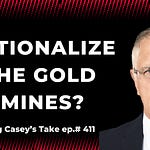Trump 2.0: Chaos as a Strategy
If you’re trying to run a business, manage investments, or even just make sense of the news these days, good luck. Under Trump 2.0, the daily news feels like weaponized chaos.
A friend of Doug’s in the hedge fund world summed it up perfectly in a ZeroHedge post titled, Every Effing Day, Bro. He described waking up to see Cambodia tariffs up 200%, Paraguay down 3%, and scrambling to figure out what tariff or sanction had just been announced while his coffee brewed. It’s funny—until you realize this is now the operating environment for everyone.
Trump’s governing style isn’t subtle. It’s “big man” politics, to borrow Bill Bonner’s term. He does things. Big things. Constantly. One day it’s a tariff on imported steel, the next it’s a peace deal between Armenia and Azerbaijan with its “Trump Route for International Peace and Prosperity”, or TRIPP. Sprinkle in an ICE hiring spree with $50,000 signing bonuses and a new export royalty on Nvidia and AMD chips, and you get the picture: perpetual motion at the top, chaos down below.
America needs big changes but the chaos makes planning impossible. If you’re importing goods, you can’t be sure what the tariffs will be by the time your shipment lands. Customs disputes can tie up inventory in warehouses, racking up fees. If you’re exporting, you don’t know if your customers will still be able—or willing—to buy once the next policy drop hits. Businesses freeze, waiting for stability that never comes.
And that’s just the economic front. On the geopolitical side, Trump is busy brokering high-profile peace deals—Rwanda and Congo, Armenia and Azerbaijan—but the details are fuzzy. MOUs get signed, but the execution? Unknown. Doug’s sure someone is getting paid off in each case, but that’s not the part we hear about. On paper it’s “more winning.” Off paper, it’s a mess.
Meanwhile, the national debt quietly crossed $37 trillion. The day they raised the debt ceiling—the so-called “big beautiful bill”—marked the start of a borrowing binge: $780 billion in new debt in just over a month. Tariffs have raised record amounts of revenue (Bonner calls it the biggest tax hike in American history), but it’s all being spent—and then some. Trump isn’t shrinking government; he’s expanding it, hiring tens of thousands of new federal enforcement employees.
From a market perspective, there’s signal in the noise if you know where to look. More money printing and deficit spending mean a weaker dollar in the long run. Precious metals—gold, silver, copper—look strong and could run much higher. Interest rate policy could get weird: short-term rates driven down by Fed appointees willing to take orders, long-term rates rising on inflation fears. That’s a trade worth watching.
The bigger question is where all this leads. History suggests governments eventually resolve prolonged chaos the old-fashioned way: war. Whether that’s in Eastern Europe, Asia, or somewhere else, the risk is rising. For now, all we can do as individuals is insulate ourselves—financially and geographically—from, as Doug puts it, “the elephants trampling the grass.”
I’m glad to be in Uruguay. Doug’s glad to be in Argentina. Here, the pace is slower, the politics are less theatrical, and the news cycle doesn’t try to kill you before breakfast.
But the U.S.? The republic is gone. The empire is in the open. And under Trump 2.0, chaos isn’t a bug in the system—it’s the system.
Join us in Uruguay for our Plan B Conference: https://www.crisisinvesting.com/p/the...
00:00 Introduction and Overview
00:03 The Chaotic Life of a Hedge Fund Manager
00:50 Trump's Influence and Global Chaos
04:32 Trade Tariffs and Business Uncertainty
06:13 ICE Hiring and Government Spending
08:22 International Deals and Diplomacy
15:13 Economic Speculations and Investments
26:27 Conclusion and Upcoming Plans










